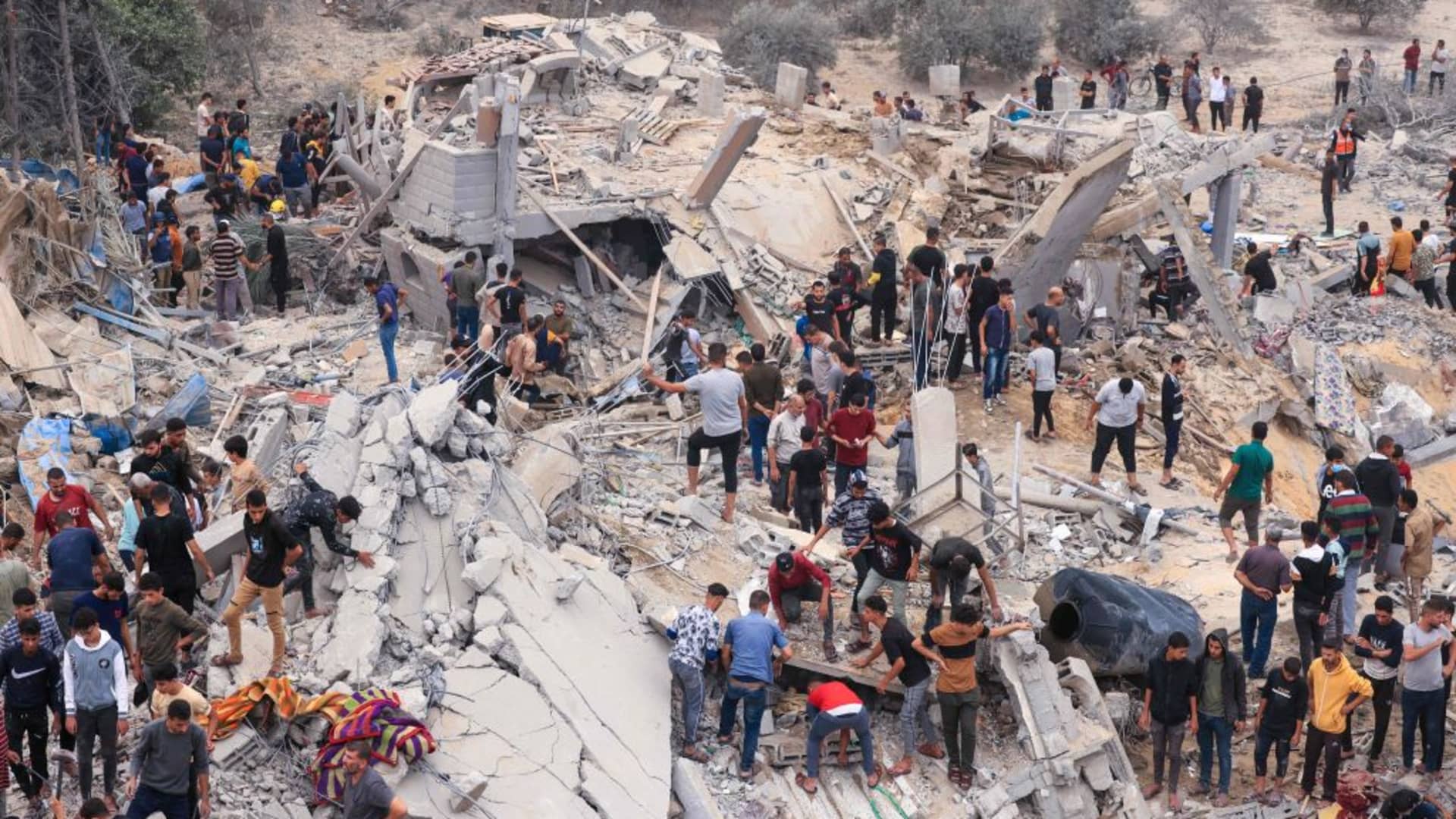Civilians and rescuers look for survivors amid the rubble of a destroyed building following an Israeli bombardment in Khan Younis in the southern Gaza Strip on November 12, 2023.
Mahmud Hams | Afp | Getty Images
War-battered Gaza’s already fragile economy lies in ruins, much like its buildings, following more than a month of bombings by Israel after Hamas militants attacked the country in October.
Even before the war, a majority of Gazans had limited access to affordable, nutritious provisions and were deemed food insecure, according to the United Nations World Food Programme, but the situation has now turned dire. About 80% of Gaza residents were reliant on some sort of international aid before the latest escalation.
“Gaza’s economy is 100% dependent on two sources of revenue: foreign aid and access to Israel’s labor market. The latter is now gone, probably forever. The only thing remaining is foreign aid,” Marko Papic, partner and chief strategist at Clocktower Group, told CNBC via email.
Gaza’s unemployment rate, which has traditionally been one of the world’s highest at above 40%, now stands near 100%, with the enclave’s economy effectively “ceasing activity” indefinitely, according to a report from the Ramallah, West Bank-based Palestine Economic Policy Research Institute.
You have a very young (Palestinian) population that doesn’t see hope … It’s very hard to see an economic future.
Kevin Klowden
Milken Institute’s Chief Global Strategies
Over one month into the war, Gazans have lost at least 182,000 jobs, or 61% of the workforce, according to the International Labor Organization. Another U.N. agency, the United Nations Development Programme, has forecast that Gaza’s development would be set back by 16 to 19 years in its assessment based on economic, health and educational indicators.
On Oct. 7, Hamas militants launched a multi-pronged attack by land, sea and air and infiltrated Israel, killing approximately 1,200 people. In retaliation, Israel launched air strikes and a ground invasion into the Gaza Strip, which has so far killed more than 14,500 people in the enclave.
Economy outlook worse than after 1967 war
“Even though the Israelis had occupied Gaza starting 1967 well into the 80s, the economy was doing a bit better, but mostly it was doing well, based on having a number of educated people who went outside of Gaza,” said Kevin Klowden, chief global strategist at Santa Monica, California-headquartered think tank Milken Institute.
Gaza was under the control of Egypt from 1948 until mid-1967 before Israel seized it along with the West Bank following its victory in the Six-Day War against a coalition of Arab countries.
“In the first 25 years of [Israeli] occupation, Gaza had both people working inside Israel [and] it had its own local economy … it was an important part of the Palestinian economy,” Raja Khalidi, director-general of the Palestine Economic Policy Research Institute told CNBC via telephone.
Gazans were able to work in Israel, Egypt, the Gulf and other places 50 years back, and there was a strong professional class, university and airport at the time, but with the current conflict the enclave’s economy now is dire, almost nonfunctional, Klowden also said.
Israel had issued about 18,000 permits for Gazans to work and live in the country and its settlements in the West Bank, but they were revoked after the Oct. 7 attack.
According to the United Nations, during the 1970s and 1980s, the Palestinian economy saw relatively strong capital inflows, largely due to remittances from Palestinian workers in Israel and the Gulf countries.
Things changed after Hamas gained power in Gaza in 2006 when Israel relinquished its control of the enclave. Hamas has not held an election in Gaza since.
That deal [to end the conflict] is likely to have to see Gulf Arab monarchies and Saudi Arabia footing much of the bill for the viability of Gaza in the future.
Marko Papic
Chief Strategist at Clocktower Group
Not only did the Palestinians lose out on working in Israel after Hamas took over Gaza, their trade with the Egyptians also dissipated as Egypt views Hamas as a threat, with investments into the Palestinian Authority-governed West Bank no longer flowing into Gaza, Klowden said.
Since 2007, Gaza has been surrounded by concrete walls and barbed wire fences after Israel imposed an air, land and sea blockade on the Gaza Strip, saying the move was necessary to safeguard itself from Hamas’ attacks. The U.N. classifies Israel as an occupier state over the Palestinian territories of the West Bank and Gaza.
“When people ask me what does it take for Gaza to get back to where it was … We want to go back to where it was 20 years ago, not where it was two months ago,” said Khalidi.
‘Hard to see an economic future’
The blockade and repeated wars with Israel since 2008 have hollowed out the enclave’s economy, with its anemic economic growth falling far behind that of the West Bank over the last 15 years, according to the International Monetary Fund.
“It’s not been a situation where there’s been economic hope. And for the last 15 years, essentially, that’s been the situation,” Klowden said. “You have a very young population that doesn’t see hope out of that. It’s very hard to see an economic future out of that.”
As many as 65% of the 2.3 million Palestinians living in the 140-square-mile sliver of land, between Israel and Egypt are under the age of 24.
“Ultimately, some form of a deal to end the conflict will have to be put in place,” said Clocktower Group’s Papic.
“But that deal is likely to have to see Gulf Arab monarchies and Saudi Arabia footing much of the bill for the viability of Gaza in the future.”
